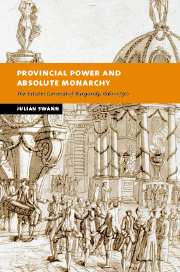Book contents
- Frontmatter
- Contents
- List of illustrations
- List of figures
- List of appendices
- List of map
- Preface
- List of abbreviations
- Map: The duchy of Burgundy in the eighteenth century
- 1 Historians, absolute monarchy and the provincial estates
- 2 Ancien régime Burgundy
- 3 The Estates General of Burgundy
- 4 Nosseigneurs les élus and the officers of the Estates
- 5 The provincial administration: authority and enforcement
- 6 ‘It's raining taxes’. Paying for the Sun King, 1661–1715
- 7 Provincial administration in an age of iron, 1661–1715
- 8 The limits of absolutism: crown, governor and the Estates in the eighteenth century
- 9 Provincial rivalries: the Estates and the Parlement of Dijon in the eighteenth century
- 10 Tax, borrow and lend: crown, Estates and finance, 1715–1789
- 11 An enlightened administration?
- 12 The coming of the French revolution in Burgundy, 1787–1789
- Conclusion
- Appendices
- Bibliography
- Index
Conclusion
Published online by Cambridge University Press: 05 July 2009
- Frontmatter
- Contents
- List of illustrations
- List of figures
- List of appendices
- List of map
- Preface
- List of abbreviations
- Map: The duchy of Burgundy in the eighteenth century
- 1 Historians, absolute monarchy and the provincial estates
- 2 Ancien régime Burgundy
- 3 The Estates General of Burgundy
- 4 Nosseigneurs les élus and the officers of the Estates
- 5 The provincial administration: authority and enforcement
- 6 ‘It's raining taxes’. Paying for the Sun King, 1661–1715
- 7 Provincial administration in an age of iron, 1661–1715
- 8 The limits of absolutism: crown, governor and the Estates in the eighteenth century
- 9 Provincial rivalries: the Estates and the Parlement of Dijon in the eighteenth century
- 10 Tax, borrow and lend: crown, Estates and finance, 1715–1789
- 11 An enlightened administration?
- 12 The coming of the French revolution in Burgundy, 1787–1789
- Conclusion
- Appendices
- Bibliography
- Index
Summary
THE FINAL ACT
Once the Estates General opened in May 1789 provincial affairs faded from view as all eyes were fixed on the drama being played out at Versailles. The lethargy of Louis XVI soon ensured that the issue of voting poisoned the political atmosphere of the Estates General in much the same way as it had already done in Burgundy. Revolution was the result, and by the end of July the Estates General had been transformed into the Constituent Assembly, the self-appointed representative of the sovereign nation, charged with endowing France with a constitution. In the new political climate nothing was sacred, and on the night of 4 August the Assembly struck a decisive blow against what was already being described as the ancien régime. Intoxicated by patriotism, fear of the violence in the countryside, or too much wine, depending on personal interpretation, deputies flocked to the rostrum to renounce the rights of the corps and provinces of the kingdom in a veritable bonfire of the privileges. At a stroke, the constitution, rights and liberties of Burgundy were swept away, and with them went the justification for the existence of the provincial estates. Even at this late stage, it was not impossible that they could be preserved as part of a reformed local government structure based upon the old provinces.
- Type
- Chapter
- Information
- Provincial Power and Absolute MonarchyThe Estates General of Burgundy, 1661–1790, pp. 400 - 412Publisher: Cambridge University PressPrint publication year: 2003

